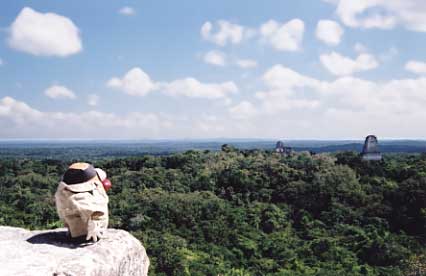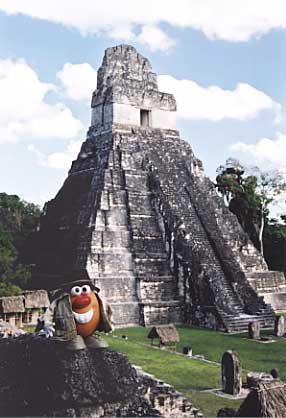 Spud
discovers the Mayan city of
Spud
discovers the Mayan city of
![]()
After exploring the amazing ruins of Chichen Itza and learning about the fascinating Mayan civilization, Spud was eager to discover more about this sophisticated and advanced society that fluorished in Mexico and Central America from the 2nd to 10th century.
Scouring through historical references and documents, the tater learned of a grand city that many believed was the crown jewel of the Maya: Tikal. A city of great power that was suddenly and mysteriously abandoned around the 11th century.
Located deep in the dense jungle of Northern Guatemala, the city encompassed a massive 120 square kilometer (~70 sq. mile) area at its peak around 750 A.D. and was inhabited by 100,000 Maya. Eager to seek out this amazing city that was the heart of the Mayan empire, Spud 'liberated' a map from one of the books and packed his backpack for the long journey back to Central America.
The potato soon realized that the texts he had been reading had understated just how vast the Guatemalan rainforest was. Spud laboured through the dense forest for days on end, using his GPS receiver and a 1200 year old map to guide him. A grueling multi-day hike through the steamy hot and humid darkness would break most mortals; succumbing to fatigue, heatstroke or relentless insect attacks. Guatemala is known for its blood thirsty mosquito population, but fortunately for Spud, they weren't interested in the Alpha Lipic acid that courses through potatoes.
 The
tuber's arduous efforts were rewarded shortly thereafter when he climbed
to the top of a hill, and saw two immense stone roof combs soaring over
the jungle canopy - signalling the location of the lost Mayan city.
The
tuber's arduous efforts were rewarded shortly thereafter when he climbed
to the top of a hill, and saw two immense stone roof combs soaring over
the jungle canopy - signalling the location of the lost Mayan city.
Tikal was every bit as impressive as the side dish had read. The city was surrounded by numerous steep-sided pyramids that rose majestically from the earthen floor to scrape the sky 40-60 metres (120-185 feet) upwards. Each of these giants was adorned with a temple on the top and finished with an impressive roof comb which was unique to Tikal.
The ancient rulers would have peasants toil for decades to build these massive stone structures; often as a memorial to their own greatness. Apparently, the Maya bigwigs were somewhat self-absorbed. The average Maya middle class folk were left to enjoy the comfy confines of their grass roofed shacks and luxurious mud floors.
During the thousand or so years of occupation, the Mayas developed an amazingly advanced society that was highly skilled and educated with their own written language. The people learned how to live in the harsh environment of the jungle. They learned to harvest the land for food by doing everything from hunting coatimundi with blow darts to boring into trees for grubs. They learned to make clothing from plants, tree bark and feathers from maccaws and quetzals. They even learned to cut and shape stone with rocks to make an irrigation system to capture and direct water reserves.
 Historians
believe the great city of Tikal was abandoned due to overfarming; that
the soil lost its fertility and was unable to sustain the growth of the
population. Spud believes that, even though he's certain the Maya enjoyed
wearing bark sandals and eating grubs, they most likely left when it became
certain that Wal-Mart had no intention of opening a store anywhere near
by.
Historians
believe the great city of Tikal was abandoned due to overfarming; that
the soil lost its fertility and was unable to sustain the growth of the
population. Spud believes that, even though he's certain the Maya enjoyed
wearing bark sandals and eating grubs, they most likely left when it became
certain that Wal-Mart had no intention of opening a store anywhere near
by.